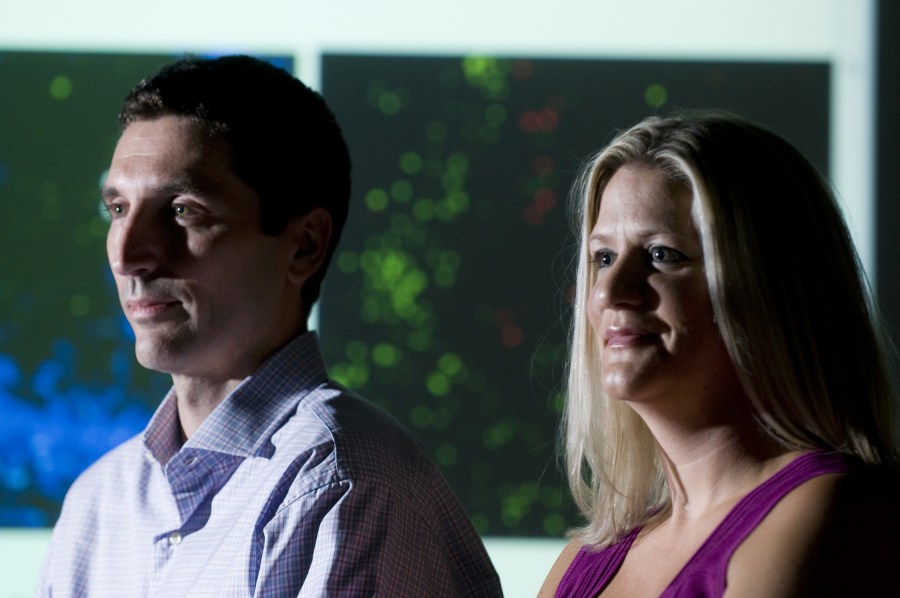
Eric Sebzda, Ph.D., Kristen Hoek, Ph.D., and colleagues are studying a protein factor involved in organizing immune system cells. (photo by Mary Donaldson)
Factor’s role in distributing immune cells discovered
Location, location, location. For the B cells that help defend us against germs, their “neighborhood” is key to their function. How these cells populate different locations in the body has been a mystery.
Investigators at Vanderbilt University Medical Center have now discovered a factor that regulates B cell distribution.
The findings, reported in the Aug. 27 issue of Immunity, offer new insights into the workings of the immune system and have implications for the development of autoimmune diseases and B cell cancers (lymphomas).
B cells — the white blood cells that produce antibodies against pathogens — come in three “flavors” with distinct roles specific to their locations, explained Eric Sebzda, Ph.D., assistant professor of Microbiology & Immunology.
B1 B cells populate the peritoneal space — the guts — and respond to pathogens arriving via the digestive tract. Marginal zone B cells occupy a specialized region (the marginal zone) of the spleen where they respond to blood-borne pathogens.
Follicular B cells, which represent the majority of B cells in the body, occupy a different region of the spleen (the follicle) and circulate through the blood and lymphoid organs (lymph nodes, spleen). They interact with T cells (another type of white blood cell) to form an immune response.
“B cells appear to be in specialized areas to do specialized functions,” Sebzda said. “The big questions are how do they segregate to these areas, and is it important?”
Sebzda and his colleagues had previously demonstrated that a transcription factor called Klf2 played a role in T cell migration (transcription factors turn genes “on” and “off”). To probe whether Klf2 also has a role in B cell migration, the researchers developed mice missing Klf2 in their B cells.
They found a dramatic change in the location of B cells: B1 B cells disappeared, marginal zone B cells shifted to a different area of the spleen, and follicular B cells migrated into the marginal zone of the spleen.
“We believe Klf2 is the first transcription factor that controls B cell circulation,” Sebzda said.
The researchers found changes in the pattern of “homing” receptors that guide B cells to their destinations, but otherwise, the Klf2-deficient B cells appeared normal: they had normal rates of cell division and antibody production in vitro.
The team next examined immune responses.
“We expected that if we messed up B cell segregation, it would be detrimental to the system,” Sebzda said. “Instead it was the complete opposite: the system was actually better.”
The Klf2-deficent mice cleared the Lyme disease-causing bacterium Borrelia burgdorferi, for example, more efficiently than mice with normal B cell populations.
The investigators demonstrated that the follicular B cells that were now present in the marginal zone of the Klf2-deficient mice responded to the pathogens in a manner that did not occur in control mice.
Why would our bodies distribute follicular B cells in a way that restricts them and limits their ability to respond to pathogens?
It could be that follicular B cells in the marginal zone are dangerous — for the development of autoimmune disease or lymphomas, Sebzda said.
The researchers are pursuing these possibilities.
“This could be a paradigm shift in thinking about autoimmune diseases. If defects in migration receptors allow B or T cells to go to the wrong places, maybe that helps initiate autoimmunity.”
It might be possible, he said, to suppress autoimmune symptoms by targeting B cell and T cell migration.
Kristen Hoek, Ph.D., a research fellow in Sebzda's lab, was the first author of the paper. Sebzda noted the particularly helpful roles of his collaborators — all from the Vanderbilt Department of Microbiology & Immunology.
The National Institutes of Health and the Edward Mallinckrodt, Jr. Foundation supported the research.













